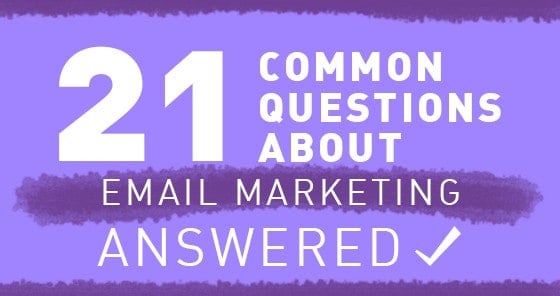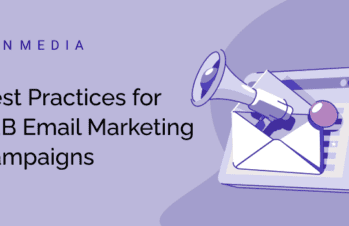Today’s installment in our series of answers to common online marketing questions addresses email marketing. Email marketing can seem like a deceptively simple task at first glance, but once you get into the trenches, it becomes clear that it’s anything but. Luckily, we’re here to help point you in the right direction. We’ve answered 21 of the most common email marketing questions we receive about B2B email marketing.
1. Is email marketing still effective?
Email marketing is one of the most effective ways for a business to reach customers directly. Think about it. You’re not posting something on your site and hoping people will visit it. You’re not even posting something on a social media page and hoping fans will see it. You’re sending something directly into each person’s inbox, where they definitely will see it! Even if they don’t open it, they’ll still see the subject line and your company’s name each time you send an email, so you’re always communicating directly with your audience.
2. Isn’t social media marketing taking the place of email marketing?
Actually, recent statistics show that email reaches three times more people than Facebook and Twitter combined. That’s a significant difference. Social media marketing is wildly popular, and becoming even more so every day, but it is definitely not taking the place of social media marketing any time soon. With social media ex. facebook if you were to make a post to reach your followers Facebook only reaches a small portion of your users. If you have users opted into your email list everyone on that list will receive that message.
3. Can I buy a list when I’m just starting out with email marketing?
It can be tempting, but you’ve got to resist that temptation. The only way to get an email subscriber list that will be beneficial to your company is to grow it organically. First of all, many email service providers won’t even allow you to use purchased lists. And secondly, the email addresses found on lists like those are not high-quality leads, to say the least. They will not contain people truly interested in your products or services, since these people didn’t opt-in to your specific email list, so they’ll also be much more likely to mark your emails as spam.
4. How should I grow my subscriber list?
The best way to grow an email subscriber list is to offer your audience an incentive in exchange for signing up to receive your emails. You can put this offer on your site, on your social media pages, on landing pages you create to get people excited – just get the word out, and your leads will automatically qualify themselves by opting in.
5. What makes a good incentive?
Any kind of content that will be seen as valuable by your particular audience. It can be an eBook, a white paper, a video, a webinar, even a coupon – anything that is attractive enough to potential customers that they are willing to give up their email address in order to get it.
6. Do I need to send an email newsletter?
For some businesses, a newsletter is the way to go. For others, a different approach works better. Newsletters usually feature several different pieces of content, such as recent blog posts and current specials. But it’s also perfectly fine to send an email featuring only one piece of content, or an individual marketing message. Tailor your email structure to your unique audience, and see what works best through experimentation.
7. How often should I send marketing emails?
As often as you can, without getting annoying. How’s that for a vague answer? But it’s true – you want to send frequent emails, but not so frequent that people start unsubscribing or worse, marking them as spam. Where’s the happy medium? Unfortunately, it’s different for each business. For some, once a month is plenty, while for others, daily emails are just fine. Again, it’s a matter of experimentation and testing to see what your particular audience responds best to.
8. What is the best day and time to send my marketing emails?
Once again, the answer to this question differs from business to business. And once again, testing is the way to find out what works best. As a general rule, weekends and mornings seem to be the times when more emails are opened – but since your audience may have different habits, it’s best to experiment and then use your own data to decide.
9. How can I make sure my emails don’t end up in the spam folder?
There are certain obvious email marketing no-nos to avoid, if you want to stay out of the spam folder – things like mentioning Viagra, or writing in all caps. But spam filters are much more sophisticated now than they used to be, so one or two trip-ups usually won’t mean the end for you. The best way to stay out of the dreaded spam folder is to write not like a salesperson, but like a friend – the tone of your emails, and even the vocabulary you use, will automatically be different.
10. Should I use HTML or plain text-based emails?
This is another case for A/B testing. There’s no one right answer, even though some people swear by the gorgeous, eye-catching images of HTML emails, and others maintain that simple text looks best in every email program and is never blocked like an image can be. Once again, it all depends on your particular audience and their preferences, so try both and see which one is most successful.
11. How long should my emails be?
The average person will only spend about 20 seconds reading an email, so use that as a guideline. If your email will take longer than 20 seconds to read, make sure that the most important information, as well as your call to action and links, are located near the top, where they can be seen without having to scroll down.
12. How do I write a great marketing email?
The single best piece of advice we can give when it comes to writing a marketing email is to keep the following in mind: The purpose of every email you write is to deepen your relationship with each individual subscriber. That means writing to them as if they were a friend, or at least a real-life person, rather than sounding like a used car salesman.
13. Should I segment my email lists?
If you have the resources to write that extra content, and the flexibility within your niche to divvy your subject matter up into segments, then by all means, yes! Segmenting your email list is a great way to personalize marketing messages according to subscribers’ individual interests, making them that much more effective.
14. Which metrics should I be looking at?
The two most important metrics for email marketing are the open rate and the click-through rate. If your emails aren’t getting opened, subscribers will never see your full marketing message – and if they’re opening them, but not clicking through to your site, your emails aren’t converting.
15. How can I get subscribers to open my emails?
The key to getting subscribers to open your emails is by writing a stellar subject line every time. Other than your company name, that’s all they have to help them make that split-second decision when they see your email in their inbox.
16. How do I write a good subject line?
The best subject lines are short and to the point, accurately describing what’s in the email – but also catchy and intriguing, so the reader wants to know more. Once again, this is the perfect place for some A/B testing, to see which types of subject lines work best with your audience.
17. How can I increase my click-through rate?
Amazingly, people are much more likely to do something if you simply ask them to. By placing a call to action in your email, specifically asking subscribers to “click here” or “shop now,” you’ll see a boost in your click-through rate.
18. How do I write a great call to action?
Your call to action should be very clear, and very simple. It should be somewhere towards the top of your email for those who won’t finish reading the whole email, and then repeated again at the end for those who do read all the way through. It should spell out exactly what you want subscribers to do, such as, “Click here to download our report.”
19. What should my From line say?
The most important thing to remember about your From email address is to make it recognizable. If subscribers see an unfamiliar name on the From line, they might just mark the email as spam. Your From line should either feature your company’s name, or an individual’s name, if you want to make it more personal – but it needs to be clear which company that individual is a part of, or subscribers will again be confused.
20. What does the CAN-SPAM law say?
This law requires anyone sending commercial emails to include an unsubscribe link within each one, include the company’s physical address or P.O. Box as well, and to honor any subscriber’s request to unsubscribe by never emailing them again. Noncompliance with this law can be as high as $300 per email recipient.
21. Should I outsource my email marketing activities?
If you have the time and resources to devote to designing, writing, testing, and tweaking your own marketing emails in-house, then by all means, do so. But if you’d rather hand those tasks off to an experienced expert, then outsourcing is the way to go. If you’d like help with your email marketing efforts, we here at Zen Media would be happy to oblige! We can help you come up with an effective email marketing strategy, and then execute it for you, so all you have to do is sit back and reap the benefits. Contact us today to get started!





